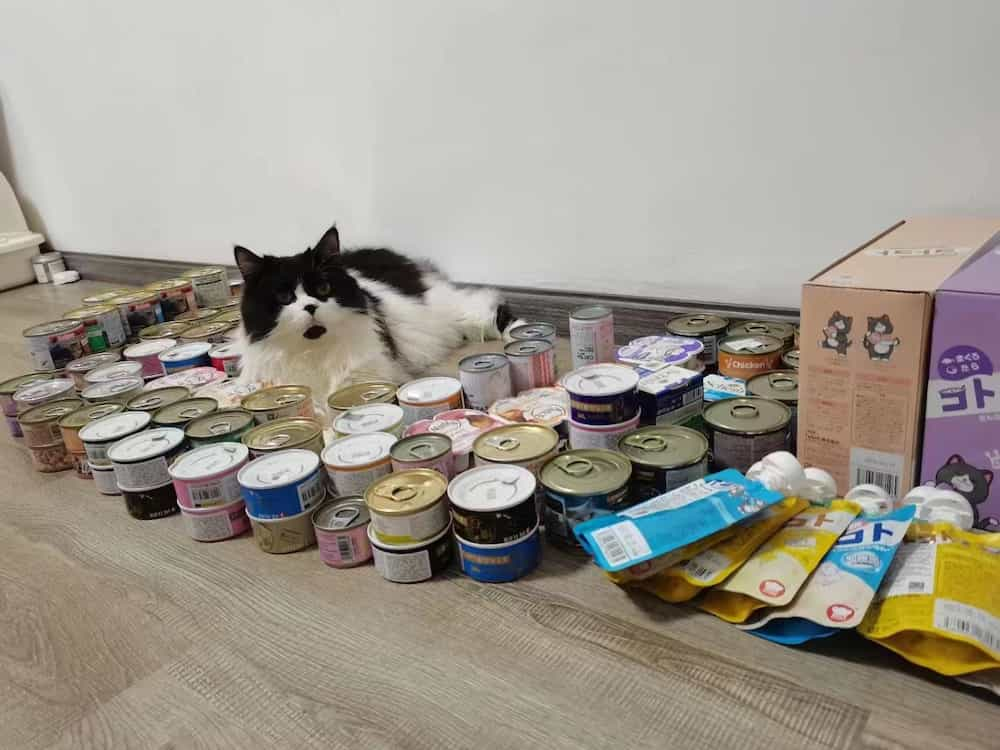Guidelines for Choosing the Right Canned Cat Food
Check Ingredients First
- Too much water content is no good.
- Meat should have exact names.
- 3 kinds of protein are at most. Too many kinds of meat are not suitable for stomach-sensitive cats.
- The fewer vegetables and fruits, the better, less than 5%.
- By-products? a matter of opinion.
1. Water will certainly be added, but how much to add?
In canning, additional water/broth will be added to dilute the meat. The final water content is about 75-83%, generally around 78%, for every 5% increase in water, the dry goods will be 1/4 less.
Water content ≤ 75%: good, just rare.
Water content ≤ 78%: OK, no problem.
Water content ≥ 83%: not OK, too much water.
2. The recipe says it is meat, specifically what meat?
Price from low to high, cheap canned food is often unclear about what meat is added. Most ordinary cans tell clearly what animal meat is added. Top quality can be accurate to the specific parts, but few.
If one can is unclear about what meat is added, it's likely that it adds by-products, that is, the leftover scraps after slaughter. There are no cheap, good-quality meat cans. How well the by-products are used varies from place to place. Generally, the UK regulations are the most ambiguous. The United States is the second worst. The EU, led by Germany, where the use of by-products requires professionals (veterinarians) to check before production, is better.
3. Gum, gum, gum!
Some common gums are carrageenan, xanthan gum, and goa gum. These gums are used to emulsify and thicken canned cat food, with a percentage of
- You can not find gums with your naked eyes. Meat jelly is not gum. The gum emulsifier is evenly dispersed throughout the cans.
- Carrageenan is controversial. There is no conclusion about the impact of carrageenan on health. If possible, it is better to choose the one that declares carrageenan-free. However, the use of carrageenan is too wide to be avoided.
- It is more practical to look at the ingredients and the protein, fat, and water content than to worry about the unclear and unexplained gum.
4. A small amount of cereal is not harmful.
Some brands recognize that some owners like "balanced meat and vegetables", so they add a little cereal and beans in cans, which are honestly, not of much use. Limited ingredients are preferred.
- It is recommended that no more than three types of vegetables be added, with the proportion being less than 5%. Actually, 0 is the best.
- It is best not to add more than 2 kinds of grains and beans, and adding 1 kind to provide fiber is actually OK. There is also grain-free and gluten-free canned cat food.
Cats are able to digest cooked grains. However, the bunch of plants, fruits, and beans will lead to extra phytic acid which reduces the absorption rate of taurine. The less, the better.
The best recipe is perhaps the most straightforward, simple, and non-gimmicky: meat, liver, heart, supplements, and fiber, with the proportions indicated.
Then Check Proportions
For canned cat food with a water content of 78%-80%:
- Protein content below 9% is not acceptable.
- Fat is the cheapest, too high is no good.
- Fat content greater than 9% can cause obesity.
- The fiber content of 1.0% or less is more reasonable.
1. Protein
It is arguably the most valuable thing in the entire canned food, taking the largest part of the cost. High protein canned cat food is recommended. Good sources of protein include lamb, pork, duck, beef, turkey, venison, and chicken.
According to AAFFCO standards, a can with about 7% protein is compliant. There are indeed manufacturers who do this. However, canned cat food with a protein content of 9% or more is the most basic.
Think about it, a lean piece of meat has 18-20% protein, and the manufacturer dilutes it to 7%. Is that selling water?
2. Fats
Fat can provide a lot of calories but is also the most worthless thing. The proportion of fat can reflect the quality of the ingredients. The less, the better.
On the other hand, higher levels of fat can provide cats with enough calories. Therefore, even though 6% fat is already not low (about 27% dry matter fat, which is greater than the natural intake of cats), we set the threshold at about 7-8%. A higher ratio of 9% or more? Then you really have to pay more attention to the amount when feeding. If the protein is still low, it is better not to buy it.
- If your cat needs to lose weight, fat ≤ 5% better.
- Protein qualified, fat ≥ 8% is suitable for kittens and thin cats.
- Protein qualified, fat adult cats and senior cats.
- High fat (over 9%) can also be eaten, but not particularly recommended.
3. Fiber
As for fiber, there is no specific rule on what an appropriate proportion is.
Too high fiber and plant content are likely to cause protein absorption rate and taurine absorption rate to reduce. 1.0% fiber is enough. A higher fiber proportion of fiber is more suitable for cats with constipation or giant colon problems. After all, 1% of the canned fiber content is equivalent to ≥ 4% of the fiber content of dry cat food.
What's Next?
For time-saving, some cat owners choose dry cat food which is easier to feed and store. Still, we recommend wet cat food and freeze-dried cat food for your cat's health. Canned cat food can relieve your cat's urinary problem and improve its skin & coat.







